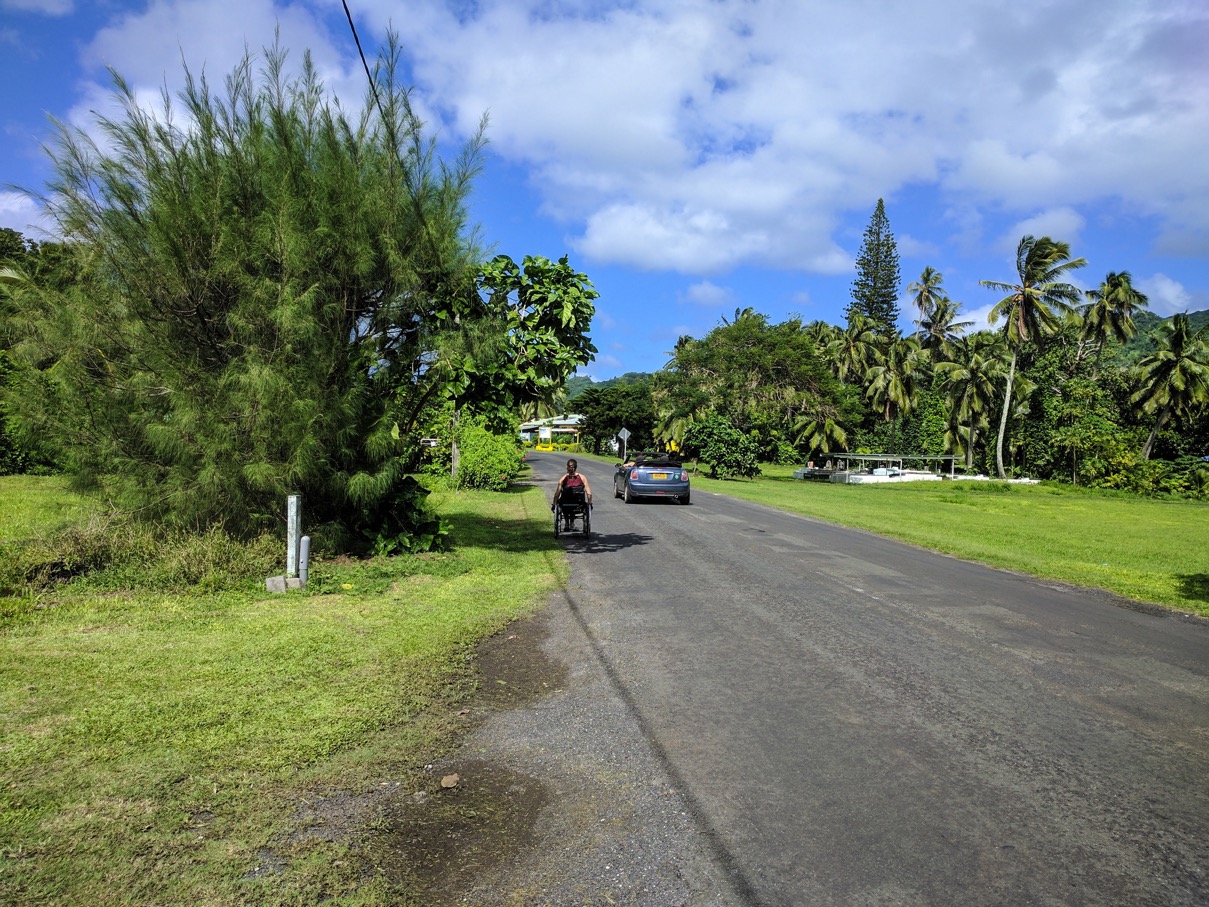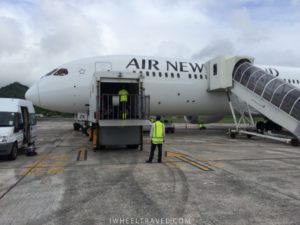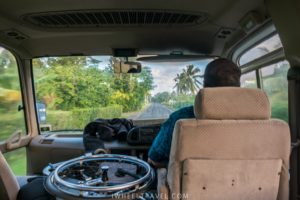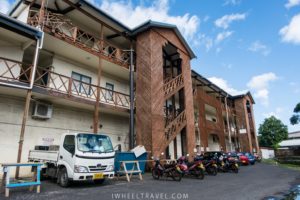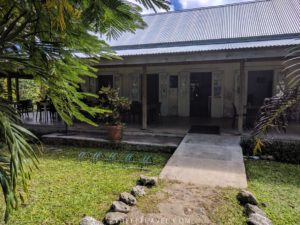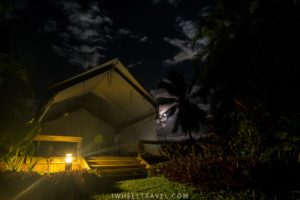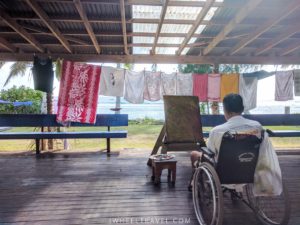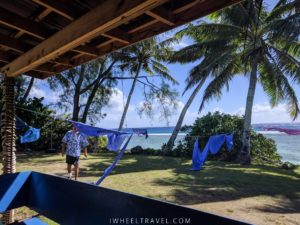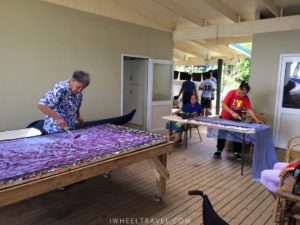Rarotonga : Accessibility and disability in the Cook islands
Rarotonga is a dream destination. Everything seems to be perfect: the palm trees, the sun, the turquoise lagoon, the Polynesian songs and the inhabitants smiles… But unfortunately disabled people, tourists and locals, have to handle several difficulties especially accessibility issues.
Sommaire
Rarotonga airport accessibility
A few minutes before the landing we heard an announcement in the plane that there is no gangway to leave the plane so passengers have to go down by using the stairs. Indeed Rarotonga airport is very small but no panic everything is organised! At the plane door I got back my wheelchair and I went in an ambulift with all the others disabled passengers to go down on the tarmac. Once in the airport there is no difficulty. This is just a ground floor so there is no need to look for an elevator. There are accessible restrooms outside the terminals and also inside near the arrivals and the departures areas. Arriving at the Cook islands was easy. Everything went good. My only disappointment was to not receive a welcoming flower necklace like the others passengers got when they reached the tarmac.
Moving around Rarotonga with a wheelchair
In Rarotonga transports are the same as elsewhere: cars, scooters, bus, bikes and taxis. I didn’t see any wheelchair accessible rental car or taxi during my holidays on the island. Bus are not wheelchair friendly either: there are stairs to get in and no wheelchair spot inside. Touristic tours’ shuttles as the island night or “progressive dinner” ones are the same: not accessible.
Fortunately the inhabitants kindness overcomes this lack of accessibility. From the first day I could notice their benevolence to me. We decided to walk from our accommodation to Muri lagoon, about 4 kilometres, and we were just walking for less than 10 minutes when a women living here offered us a lift. A few minutes later we were at the beach! The same thing happened on our last days in the island. We just brought back the car to the rental agency and were walking to the church to assist a wonderful mass when a young woman asked us if we would like a lift. At the end of the mass the priest and his family also drop us off to the airport whereas we didn’t ask for anything.
Pathways and building are not very accessible. There are usually no dropped curb to get in and out of pathways. Most of the time it is only possible to get in through a garage exit. Sometimes it is easier to roll on roads. In addition it doesn’t seem to bother anybody. The main road, going all around the island, is paved so it is easy to roll on it. On the contrary it is difficult to move around in the Muri Night Market and in the Punanga Nui Market as the ground is made of gravels. Unfortunately no beach provides a layout for wheelchair users.
Many shops and restaurants are not accessible but the CITC pharmacy in Avarua and some shops around are. The “LBV- Le Bon Vivant” in Muri beach is also wheelchair accessible as there is a ramp. But before reaching there are some trees roots on the ground. In restaurants another solution is possible: you could eat at the terrace and ask a waiter to order for you as some outside seating area are accessible even if counters and inside areas are not.
Finding a wheelchair accessible accommodation in Rarotonga
Finding a completely wheelchair friendly accommodation with a fitted out bathroom in Rarotonga is possible but the prices are expensive. Indeed only a few top of the range resort have accessible rooms. Here is a list of some establishments I contacted and who assured me of their possibility to host a wheelchair user. Here are the informations they gave to me:
Aro’a Beachside Inn : Two of their “Beachside Deluxe units” are fully handicapped accessible. They have ramps up to the rooms (no stairs) and easy access through the room to the bathroom. Bathrooms are set up as open plan ‘wet rooms’ – so can get a wheelchair into the bathroom – as well as having hand rails and a shower chair. There is a ramp up to the bar which means that guests in wheelchairs can easily get to it where breakfast is served each morning. A night costs NZ$395.
The rarotongan : The accessible rooms are the following: “Deluxe Beachside Suites”, “Deluxe Beachfront Suites” and “Grand Beachfront Suites”. The resort has covered walkways along with solid pathways to enable comfortable wheelchair access to wheelchair accessible rooms. The bar-restaurant is accessible. The tenants also mentioned to me that whilst the wheelchair facilities are not to the official standard required in New Zealand or Australia for example, they have host many guests in wheelchairs over the years. A night costs NZ$325 for a “Deluxe Beachside Suite”, NZ$395 for a “Deluxe Beachfront Suite” and NZ$545 for a “Grand Beachfront Suites”
Edgewater Resort: Villa 19 and Villa 20 are completely wheelchair accessible. They are standalone villas with no steps or extra floors. They have a wheel in shower/flat shower. A 3 Bedroom Villa is NZ$740.00 per night on a minimum stay of 5 nights.
Sunset resort : The only wheelchair accessible room is the “Two bedroom Poolside Suite”. The bathroom is equipped with handrails and shower chair. There are handrails to enter swimming pools but there are still a few steps. A night costs NZ$428 on a minimum stay of 3 nights.
All these previous informations were given to me by the hotels but I didn’t stay at any of them because it is too expensive for us. Instead we stayed at “Ikurangi Eco Retreat” for a lower price of NZ$249 per night. Their accommodations are not accessible: there are steps to get into the rooms and bathrooms are not equipped to fit a wheelchair. We still chose them because they care about sustainability. Here there is no air conditioning, shower products are organic and we sleep in Polynesian units or luxury tents with outside bathrooms. We booked an unit but for unknown reasons we were upgraded to a luxury tent. We never regret ted that we choose Ikurangi. The atmosphere and surroundings were perfect and, in addition, tenants have been really kind to us during all our stay. They gave us the tent closest to the parking, which has the less steps to get in and they added a bench in the bathroom for me. They also gave us a ride to the convenience store when we arrived as it was Sunday and there are almost no buses on Sundays.
Living with a disability in Rarotonga: meeting with the Creative Centre
Accessibility is not a priority in the Cook islands but inhabitants have been considerate with me so I was curious to know how are the local disabled people doing in Rarotonga. So we went to the Creative Centre. Since 2001 this centre is a place caring for disabled people from Monday to Friday during the day. The purpose is to provide these people education, social relationships and treatments in a considerate place. The centre is funded by the Cook island ministry of education and the New Zealand State. It also receive material and financial helps from others countries such as Japan, China and India.
Eight people work at the centre and about twenty disabled people come here almost everyday. Most of the students (that how they are called) have a mental disability and some of them have a physical disability. All of them are over the age of majority. Allan, one of the workers, explained to us that people suffering from mental diseases are staying at the hospital and that children have to stay at school until 16 years-old. Apparently there are people caring and helping them at school.
To work at the Creative Centre, the most important thing is to care, not to have a psychology or social worker degree. For example before working here Allan was a builder but his mother had three strokes and died a few months later. During those months he learnt how to give therapeutic massages to ease his mother’s pain. After she died he wanted to continue helping and look after people, so he started to work at the Creative Centre which includes being a physiotherapist.
Allan also told us that there are others disabled people in Rarotonga but that they are not coming in the Centre mainly because their family want to keep them hidden. They don’t want others people to know that there is a disabled in the family… Despite the locals kindness to me and the many smiles the handicap still seems to be taboo and disabled appears to be excluded. The only people who come to the Creative Centre are tourists. Inhabitants don’t come. It is hard to know the reasons of this difference of esteem. Is it because I am a tourist? Is it because my disability is only physical and that I don’t have communication issues? I don’t know.
Luckily at the Creative Centre nobody thinks this way. The atmosphere is warm and workers encourage everybody to express themselves and to blossom. Everyday there is a different program in which students are involved. Those who can not participate are not left aside as at least one worker will be with them. Programs often include art lessons. It could be painting, singing, playing music, learning maori culture or making poteries. The day we visited the Centre sarong activity was scheduled so we learnt how to paint and dye sarongs and t-shirt. Then we helped students to do so. These sarongs will be sold in the Creative Centre shop at the Punanga Nui Market and funds will help to maintain the place.
Sometime activities are more traditional. It can be a literature or maths class or priority can be well-being and treatments. For instance, the day before all the students had an ophthalmic check-up. Workout exercises and physiotherapist sessions are also regular activities.
You want to know more about the Cook islands? You can read about Rarotonga amazing lagoons and the activities to discover this Polynesian culture.

